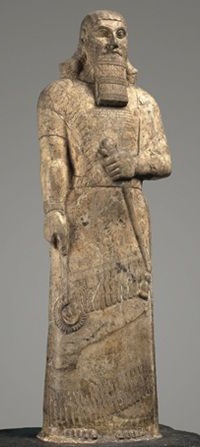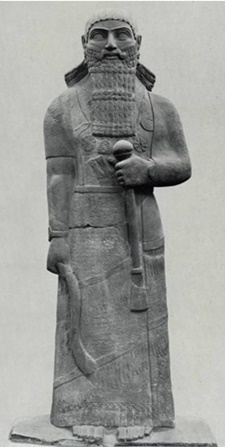Print Article
Author's Bias | Interpretation: conservative | Inclination: dispensational | Seminary: none
 Ashurnasirpal II
British Museum |
 Shalmaneser III
Museum of the Ancient Orient |
Located in the Museum of the Ancient Orient in Istanbul is the large basalt statue of Shalmaneser III. With
the same posture as the statue of his father Ashurnasirpal II, the statue of Shalmaneser III stands with a mace
in his left hand, which is a symbol of the king. In contrast to the image of his father, who is holding a sickle
in his right hand, the statue of Shalmaneser III includes two daggers under his belt, a curved club in his right
hand, and four emblems of the Assyrian gods Adad, Shamash, Ishtar, and Sin.
Shalmaneser III was the fourth king to reign over the Neo-Assyrian Empire (859-824 B.C). During
his long reign, he expanded the empire north and east.
Below the waist of the statue, inscribed on his attire, are Assyrian cuneiform memorializing Shalmaneser III's
military conquests (the lands of Urartu, Syria, Namri, Que, and Tabal) and building construction. Pertinent to the
Bible are the Assyrian inscriptions about Aram – Damascus king Hazael of which a small portion of its translation
is shown here:
Hadad-ezer (Adad-idri) passed away. Hazael, son of a nobody (Assyrian: mār lā mammāna),
took the throne. He mustered his numerous troops; (and) he moved against me to do war and battle. fought with
him. I decisively defeated him. I took away from him his walled camp. In order to save his life he ran away. I
pursued (him) as far as Damascus, his royal city. cut down his orchards.
The Assyrian cuneiform phrase "son of nobody (Assyrian: mār lā mammāna)" was a common expression
in Assyrian / Babylonian documents used to portray a ruler, whose father was not a legal member of the royal family,
in a negative light. Hazael was not first in line for succession and seized the throne as a usurper.
These Assyrian cuneiform inscriptions corroborate the Bible's portrayal of the king's servant Hazael murdering
king Ben Hadad II and taking his throne, which makes the Bible's detailed narrative of Hazael's official status
and manner of killing all the more plausible.
Then Elisha came to Damascus. Now Ben-hadad king of Aram was sick, and it was told him,
saying, "The man of God has come here." The king said to Hazael, "Take a gift in your hand and go to meet the man
of God, and inquire of the Lord by him, saying, 'Will I recover from this sickness?'" So Hazael went to meet him
and took a gift in his hand, even every kind of good thing of Damascus, forty camels' loads; and he came and stood
before him and said, "Your son Ben-hadad king of Aram has sent me to you, saying, 'Will I recover from this
sickness?'" Then Elisha said to him, "Go, say to him, 'You will surely recover,' but the Lord has shown me that he
will certainly die." He fixed his gaze steadily on him until he was ashamed, and the man of God wept. Hazael said,
"Why does my lord weep?" Then he answered,"“Because I know the evil that you will do to the sons of Israel: their
strongholds you will set on fire, and their young men you will kill with the sword, and their little ones you will
dash in pieces, and their women with child you will rip up." Then Hazael said, "But what is your servant, who is
but a dog, that he should do this great thing?" And Elisha answered, "The Lord has shown me that you will be king
over Aram." So he departed from Elisha and returned to his master, who said to him, "What did Elisha say to you?"
And he answered, "He told me that you would surely recover." On the following day, he took the cover and dipped it
in water and spread it on his face, so that he died. And Hazael became king in his place.
(2 Ki 8:7-15)
Mentioned frequently in the Bible, Hazael was one of the most powerful kings of Aram – Damascus and reigned
842-805 B.C.
Hazael ruled contemporaneously during the Judah kings: Jehoram, Ahaziah, Athaliah and Joash,
and Israel kings Jehu and Jehoahaz.
He Led frequent border skirmishes with Judah and conquered much of Israel
(2 Ki 13:3) in expanding his kingdom.
Despite losing on the battlefield, Hazael withstood two attempts by Shalmaneser III to take
his capital Damascus (841 and 838 B.C.), and this image as a powerful ruler endured as Assyrian records associate
Hazael's name to Damascus more than a century after his death.
In his victory stele, the Tel Dan Stele,
which scholars see as a propaganda tool, the first four lines of the broken stele and fragmented text reads:
1. [ ... ...] and cut [ ... ]
2. [ ... ] my father went up [against him when] he fought
at [ ... ]
3. And my father lay down, he went to his [ancestors]. And the king of I [s-]
4. rael entered
previously in my father's land. [And] Hadad made me king.
Hazael makes no mention of his usurpation of the throne and authenticates his kingship by
invoking the god Hadad as selecting him.
References:
1. Luckenbill DD, Ancient Records of Assyria and Babylonia, vol. 2, Chicago: University of Chicago Press (1927).
2. Noegel SB, "The Zakkur Inscription" in The Ancient Near East: Historical Sources in Translation, ed. Chavalas MW, London: Blackwell (2006), 307-311.
3. Younger Jr. KL, "'Haza'el, Son of a Nobody': Some Reflections in Light of Recent Study" in Writing and Ancient Near Eastern Society. Papers in Honour of Alan R. Millard, eds. P. Bienkowski et al., New York and London: T & T Clark International/Continuum (2005).
Copyright ©
2018
Helpmewithbiblestudy.org. All rights to this material are reserved. We encourage you to print the material for personal and
non-profit use or link to this site. If you find this article to be a blessing, please share the link so that it may rise in
search engine rankings.